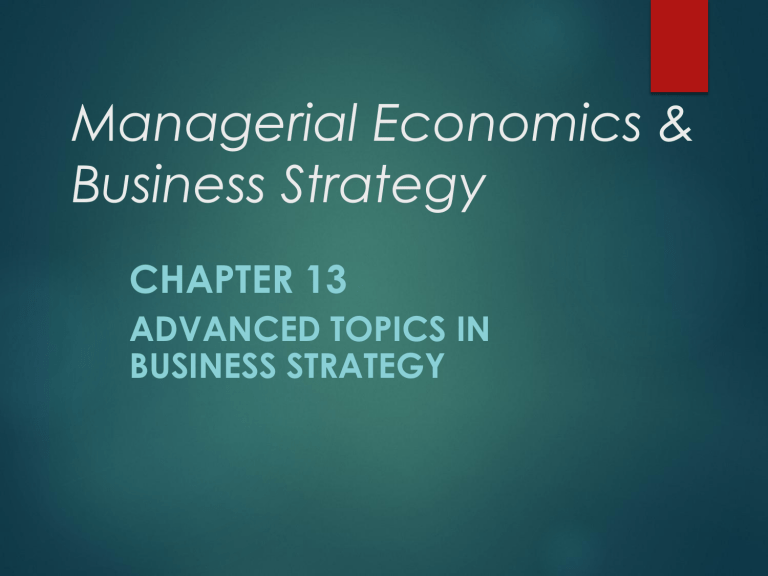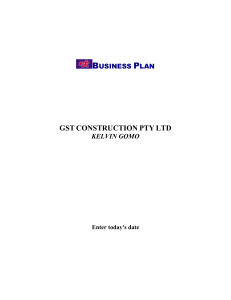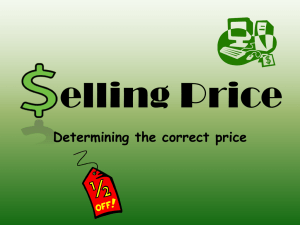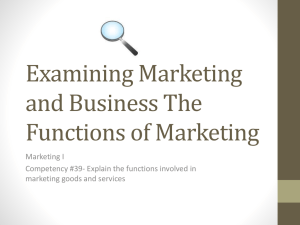
Managerial Economics & Business Strategy CHAPTER 13 ADVANCED TOPICS IN BUSINESS STRATEGY Overview I. Limit Pricing to Prevent Entry II. Predatory Pricing to Lessen Competition III. Raising Rivals’ Costs to Lessen Competition IV. Price Discrimination as a Strategic Tool V. Strategic Commitment and Changing the Timing of Decisions Limit Pricing Strategy where an incumbent (existing firm) prices below the monopoly price in order to keep potential entrants out of the market. Goal is to lessen competition by eliminating potential competitors’ incentives to enter the market. Monopoly Profits • This monopolist is earning positive economic profits. • These profits may induce other firms to enter the market. • Questions: Can the monopolist prevent entry? If so, is it profitable to do so? $ M MC PM AC AC M DM Q QM MR Limit Pricing Incumbent produces QL instead of monopoly output (QM). Resulting price, PL, is lower than monopoly price (PM). Residual demand curve is the market demand (DM) minus QL . Entry is not profitable because entrant’s residual demand lies below AC. Optimal limit pricing results in a residual demand such that, if the entrant entered and produced Q units, its profits would be zero. Limit Pricing $ Entrant's residual demand curve P M PL AC DM P = AC Q QM QL Quantity Potential Problems with Limit Pricing It isn’t generally profitable for the incumbent to maintain an output of QL once entry occurs. Rational entrants will realize this and enter. Solution: Incumbent must link its pre-entry price to the post-entry profits of the potential entrant. Possible links: Commitments by incumbents. Learning curve effects. Incomplete information. Reputation effects. Potential Problems with Limit Pricing (Continued) Even if a link can be forged, it may not be profitable to limit price! Limit pricing is profitable only if the present value of the benefits of limit pricing exceed the up front costs: L D i M L. Predatory Pricing Strategy of pricing below marginal cost to drive competitors out of business, then raising price to enjoy the higher profits resulting from lessened competition. Goal is to lessen competition by eliminating existing competitors. Potential Problems with Predatory Pricing Counter strategies: Stop production. Purchase from the predator at the reduced price and stockpile until predatory pricing is over. Rivals can sue under the Sherman Act But it is often difficult for rivals to prove their case. Upfront losses incurred to drive out rivals may exceed the present value of future monopoly profits. Predator must have deeper pockets than prey. Situations Where Predation is Rational Asymmetry in information about costs or market demand between incumbents and entrants Incumbent can make the entrant lower its expectation regarding post entry profits Predatory Pricing and Reputation of the Incumbent With uncertainty, predatory pricing can deter entry. If the incumbent does not slash prices, other challengers may consider him ‘easy’ rather than ‘tough’. An incumbent can be ‘tough’ either due to low costs or due to an irrational desire for market share. To deter entry, incumbent has to establish a reputation for toughness. Raising Rivals’ Costs Strategy where a firm increases the marginal or fixed costs of rivals to distort their incentives. Not always profitable, but may be profitable as the following example shows. Raising a Rival’s Marginal Cost Cournot duopoly. Initial equilibrium at point A. Firm 1 raises the marginal cost of Firm 2, moving equilibrium to point B. Firm 1 gains market share and profits. Other Strategies to Raise Rivals’ Costs Raise fixed costs in the industry. If vertically integrated, increase input prices in the upstream market. Vertical Foreclosure: Integrated firm charges rivals prohibitive price for an essential input. The Price-Cost Squeeze: Integrated firm raises input price and holds the final product price constant. Price Discrimination as a Strategic Tool Price discrimination permits a firm to “target” price cuts to those consumers or markets that will inflict the most damage to the rival (in the case of predatory pricing) or potential entrants (in the case of limit pricing). Meanwhile, it can continue to charge the monopoly price to its other customers. Thus, price discrimination may enhance the value of other pricing strategies. Changing the Timing of Decisions or the Order of Moves Sometimes profits can be enhanced by changing the timing of decisions or the order of moves. When there is a first-mover advantage, it pays to commit to a decision first. When there is a second-mover advantage, it pays to let the other player move first. Examples of Games with First and Second-Mover Advantages Example 1: Player naming the smaller natural number gets $10, the other players get nothing. First-mover Example 2: Player naming the larger natural number gets $10, the other players get nothing. Last-mover always earns $10. always earns $10 Practical Examples? If Firms A and B Make Production Decisions Simultaneously Firm B Firm A Strategy Low Output High Output Low Output $30, $10 $10, $15 High Output $20, $5 $1, $2 Firm A earns $10 by playing its dominant strategy, which is “Low Output.” But if A Moves First: Firm A can earn $20 by producing a high output! Requires Commitment to a high output. Player B observes A’s commitment prior to making its own production decision. Low Output Low Output ($30, $10) High Output ($10, $15) Low Output ($20, $5) High Output ($1, $2) B A High Output B Conclusion A number of strategies may enhance profits: Limit pricing. Predatory pricing. Raising rivals’ costs. Exercising first- or second-mover advantages. Penetration pricing. These strategies are not always the best ones, though, and care must be taken when using any of the above strategies.





